活性氧与肿瘤研究进展
肿瘤微环境对肿瘤代谢的影响及研究进展

肿瘤微环境对肿瘤代谢的影响及研究进展一、综述在肿瘤微环境中,肿瘤细胞与其周围组织之间的相互作用对于肿瘤的发展和代谢过程具有重要的影响。
越来越多的证据表明,肿瘤代谢重编程是肿瘤恶性表型的一个关键特征,并且与肿瘤生长速度、侵袭、转移和患者生存率密切相关。
本文将对肿瘤微环境对肿瘤代谢的影响进行综述,探讨肿瘤代谢的改变以及这些改变如何促进肿瘤的发展。
肿瘤微环境的缺氧状态是众所周知的一个特点。
肿瘤缺氧可以导致肿瘤细胞对葡萄糖的摄取和利用增加,同时减少乳酸的产生。
这种现象被称为“Warburg效应”,是指肿瘤细胞倾向于使用葡萄糖进行糖酵解以产生能量,即便在氧气供应充足的条件下也是如此。
尽管糖酵解是一种高效的产生能量的途径,但它并不总是高效的,可能会导致肿瘤细胞的代谢压力和生长抑制。
肿瘤微环境中的肿瘤相关成纤维细胞(CAF)也对肿瘤代谢产生了重要影响。
CAF是一种表型多样的间质细胞,它们可以通过促进肿瘤血管生成、胶原蛋白沉积和肿瘤干细胞维持等机制来促进肿瘤生长和侵袭。
一些研究表明,CAF可以通过代谢支持肿瘤细胞对葡萄糖的需求,从而促进肿瘤的代谢重编程。
肿瘤微环境中的巨噬细胞也对肿瘤代谢产生影响。
巨噬细胞可以根据其表型和微环境中的信号通路被极化为不同的炎性亚型,如M1和M2。
研究者们发现肿瘤相关巨噬细胞(TAM)可能与肿瘤的生长、侵袭和代谢有密切关系。
一些研究表明,TAM可以通过促进肿瘤血管生成和代谢重编程来促进肿瘤生长。
肿瘤微环境通过影响肿瘤细胞的代谢重编程来促进肿瘤发展。
为了更深入地理解肿瘤代谢的特点和机制,未来的研究需要继续关注肿瘤微环境的组成和功能,以及肿瘤细胞、CAF、巨噬细胞等不同细胞类型与肿瘤代谢之间的关系。
1. 肿瘤微环境的定义和重要性肿瘤微环境(Tumor Microenvironment,简称TME)是肿瘤发生、发展及治疗过程中与其相互作用的外部环境。
它主要包括肿瘤细胞、内皮细胞、免疫细胞、成纤维细胞等实体以及它们之间的相互作用和分泌的物质。
活性氧在生物体内的作用及其研究

活性氧在生物体内的作用及其研究活性氧(Reactive Oxygen Species,ROS)是指氧分子在体内引起电子失衡、单电子化和能量激发等过程后所产生的过渡态氧化物种,包括超氧阴离子(O2^-)、过氧化氢(H2O2)、羟自由基(OH·)和单线态氧( ^1O2)等。
ROS在生物体内广泛存在,是生命活动中的重要媒介和信号分子。
合适的浓度和位置可以促进生长发育、调节代谢和免疫等生理反应,但是过多的ROS则会对细胞膜、DNA和蛋白质等造成氧化损伤,导致细胞死亡和疾病的发生。
ROS的产生来源广泛,包括线粒体呼吸链(80%)、细胞色素P450、NADPH氧化酶等酶类,以及外界环境、烟草、辐射和化学药物等引起的各种应激刺激,其中冷冻、晒伤、感染和损伤等会引起迅速的ROS增加。
为了维持内部氧化还原环境的稳定和避免ROS的氧化损伤,生物体内还存在多种保护系统,如超氧化物歧化酶、谷胱甘肽还原酶和热休克蛋白等。
近年来,随着对ROS代谢途径、信号通路和调控机制的深入了解,ROS的研究也得到了极大的发展。
研究人员发现ROS能够通过与细胞膜、蛋白质和DNA等相互作用,参与到多种功能的调控中。
例如,ROS可以刺激蛋白激酶、转录因子和离子通道等的活性,引发胚芽发育、光敏反应、细胞增殖和凋亡等生理过程。
研究人员还发现,改变ROS浓度和通路的干预措施可以用于预防和治疗多种疾病。
例如,短时间内的低浓度ROS刺激可以增强机体的免疫力,预防肿瘤和感染等疾病;而低浓度的H2O2可以通过调控细胞增殖和凋亡来促进创伤愈合和组织修复。
此外,干细胞、肿瘤和神经退行性疾病等研究领域也正在积极探索ROS的作用和机制。
虽然ROS的作用已经得到了广泛研究,但是ROS在生物体内的复杂特性和功能还有很多未知之处。
例如,ROS参与到细胞信号转导的分子机制还未完全明确;ROS的作用在不同物种、组织和环境中可能存在差异,需要针对特定问题进行深入探讨。
活性氧在化疗药物抗白血病中的研究进展
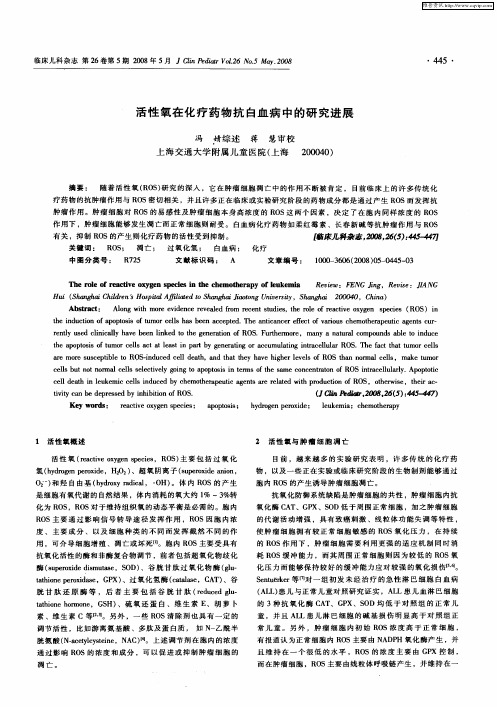
clda ue i cl d cdb hm tea ui aet ferl e t po ut no O ,o ews ,te c e et i l km c e s nu e ce o rp t gns Y a dw h rd c o R S t ri h ne i y h e c et i l i f h e hi a- r
维普资讯
临 床儿科 杂志 第 2 6卷第 5期 2 0 0 8年 5月 J C i e i rV 1 6 N . y 2 0 l nP da o. o5 Ma . 0 8 t 2
・
45・ 4
活性 氧在 化 疗 药 物 抗 白血 病 中 的研 究 进 展
有关 ,抑制 R S的产生则化疗药物 的活性受 到抑制。 O
关 键词 : R S 凋 亡 ; 过 氧 化 氢 ; O ; 白血 病 ; 化 疗
雎 床 儿科杂 岙,0 82 ( )45 4 刁 2 0 ,6 5 :4- 4
文 章 编 号 : 10 — 6 6 2 0 )5 0 4 — 3 0 0 30 (0 8 o — 4 5 0
冯 婧综 述 蒋 慧 审 校
上海 交通 大学 附属 儿 童 医院 ( 上海 2 0 4 ) 0 0 0
摘 要 : 随 着 活 性 氧 ( O ) 究 的 深 入 ,它 在 肿 瘤 细 胞 凋 亡 中 的作 用 不 断 被 肯 定 , 目前 临 床 上 的 许 多 传 统 化 R S研 疗 药 物 的抗 肿 瘤 作 用 与 R S密切 相 关 ,并且 许 多 正 在 临 床 或 实验 研 究 阶段 的药 物 成 分 都 是 通 过 产 生 R S而 发 挥 抗 O O
一氧化氮治疗肿瘤的研究进展

一氧化氮治疗肿瘤的研究进展作者:王丽凯,田娅,吴惠霞来源:《上海师范大学学报·自然科学版》2022年第04期摘要:一氧化氮(NO)是一种半衰期很短的气体分子,对细胞膜具有高穿透性,能在人体内传递重要信息,并具有调节细胞的功能.NO气体分子既能维持正常细胞的生理功能和活性,又能选择性地快速耗尽肿瘤细胞的能量,诱导肿瘤细胞凋亡.研究表明:NO可以通过多种机制實现肿瘤治疗.已有一些NO供体药物表现出良好的抗肿瘤活性,精确控制NO在肿瘤部位的释放,可杀死肿瘤细胞.因此,NO气体疗法作为一种肿瘤治疗策略具有一定的应用前景.文章简述了NO的生理学特性和几种典型的NO供体,以及释放NO的生物材料在生物医学领域的应用进展.关键词:一氧化氮(NO); NO供体; 肿瘤; 气体治疗; 生物材料中图分类号: O 613.6 文献标志码: A 文章编号: 1000-5137(2022)04-0443-09Research progress of nitric oxide in the treatment of tumorWANG Likai, TIAN Ya, WU Huixia*(College of Chemistry and Materials Science, Shanghai Normal University, Shanghai 200234, China)Abstract: Nitric oxide (NO) is a ubiquitous gas molecule with a short half-life. It is highly permeable to cell membranes and can transmit important information and regulate cellular functions in the human body. NO molecules can not only maintain the physiological function and activity of normal cells, but also selectively and rapidly deplete the energy of tumor cells and induce their apoptosis. Studies have shown that NO may achieve tumor therapy through a variety of mechanisms. Some NO donor drugs have shown good anti-tumor activity and can be used to precisely control the release of NO at tumor sites and kill tumor cells. Therefore, NO gas therapy is a promising tumor treatment strategy. This review covers the physiological characteristics of NO, several typical NO donors, and the application progress of NO releasing biomaterials in biomedical field.Key words: nitric oxide(NO); NO donors; tumor; gas therapy; biomaterials0 引言一氧化氮(NO)是一氧化氮合酶(NOS)作用产生的半衰期仅为3-5 s的分子.NO分子中有一个未成对电子,可形成自由基,对多种生物分子具有很高的反应性.NO具有脂溶性,可以快速透过生物膜扩散,在体内极不稳定,能迅速被血红蛋白、氧自由基或氢醌等灭活.NO可以对血管生成和舒张、细胞周期、细胞凋亡、侵袭和转移等过程进行调节,从而影响细胞功能.NO还能与二氧化氮(NO2)反应生成三氧化二氮(N2O3),并能与超氧化物反应生成过氧亚硝酸盐(ONOO-).N2O3和ONOO-这2种分子均可通过亚硝化或氧化应激引起DNA损伤:N2O3可以通过胺的亚硝化作用导致N‒亚硝胺的形成,进而损伤DNA;过氧亚硝酸盐可以氧化和硝化DNA,并导致单链DNA断裂[1].NO的生物效应通常取决于分子的形成、代谢、NOS的类型和NO的浓度等.在过去的几十年中,人们一直在努力研究NO对癌生物学的影响.多年来,NO在致癌和抗肿瘤进展中有着较大的误解和争议,因为它同时具有促进肿瘤细胞生长和杀死肿瘤细胞的能力.然而,确定哪种作用占优势是很复杂的,包括但不限于NO存在的时间、位置、浓度和肿瘤微环境[2].NO生成过多或者生成不足都会引起基因突变、肿瘤等.近年来,许多气体纳米发生器已经能够通过被动或主动靶向聚集在肿瘤部位,在内源性或外源性刺激下有效控制气体分子的释放.因此,无论是单独使用NO还是与其他治疗方式联合使用,这些发现都使NO广泛应用于抗癌剂[3].目前,气体治疗已成为一种新兴的、安全有效的抗癌治疗策略.1 NO的生理学特性1.1 NO的生物合成细胞合成NO的主要途径是通过NOS的酶促作用将L‒精氨酸转化为L‒瓜氨酸,并释放出NO,如图1所示[4].NOS是一种同工酶,选择性分布在不同脑区的神经元中,其同工酶有3种亚型,即神经型一氧化氮合酶(nNOS)、诱导型一氧化氮合酶(iNOS)和内皮型一氧化氮合酶(eNOS).其中,eNOS和nNOS在细胞处于生理状态下即可组成性表达,并可因细胞内钙增加而被钙调蛋白激活;iNOS是非钙依赖型的,当细胞受到内源性或外源性刺激时,可在较短的时间内产生高浓度的NO[4].此外,还可以通过硝酸盐→亚硝酸盐→NO途径合成NO.体内的硝酸盐主要来自膳食和自身合成.在生物体内,循环的硝酸盐被唾液腺主动摄取,并被口腔中的细菌还原为亚硝酸盐,在血液和组织中进一步代谢为NO和其他生物活性氮氧化物[5].亚硝酸盐是氮氧化物的氧化还原过程中的中间产物,在血液和组织中比较稳定,且可被多种物质还原成NO,包括肌红蛋白、血红蛋白、抗坏血酸、黄嘌呤氧化还原酶、质子和多酚[5].这些途径产生的NO会因缺氧和酸中毒条件而增加,因而可以保证NO的产量.1.2 NO的生物学作用NO可以自由地通过生物膜并参与一系列生理和病理过程,如神经信号传递、血管扩张、血小板黏附和聚集等,在生物体内发挥着至关重要的作用.NO的生物学作用是通过直接或间接的化学反应产生的.例如,NO直接与不同蛋白质的金属配合物结合形成金属亚硝酰基配合物来调节靶蛋白的生物学活性.NO还可以与多种内源性自由基反应,产生活性氮氧化合物,这些强毒性的活性氮氧化合物将导致线粒体损伤,进而诱导细胞凋亡.NO在生物体内像一把双刃剑,因为它既具有杀死肿瘤细胞的作用,又具有促进肿瘤细胞生长的作用.在低生理水平下,NO可作为抗氧化剂,减少芬顿反应,终止自由基链式反应,并抑制过氧化物酶和氧化酶的活性.较高浓度的NO能够舒张血管,改善组织缺氧状态,有利于化疗药物的渗透,对肿瘤细胞具有杀伤作用[6].但是,持续过量的NO将产生神经毒性,影响体内平衡和改变蛋白质功能,从而导致基因突变,最终使正常黏膜癌变[7].不同组织中的生理过程对NO的需求量各不相同,浓度过高或者过低都会对组织造成一定的损伤,引起疾病的发生[8].只要将适当浓度的NO递送至肿瘤部位,NO的靶向释放也可能增强化学疗法和放射疗法的疗效.因此,如何将适当浓度的NO靶向释放至肿瘤,已成为近年来生物医学领域的研究重点.2 NO供体直接使用外源性或内源性NO的缺点是其半衰期极短,且易受各种谷胱甘肽(GSH)、超氧化物和血红蛋白等物质的影响.因此,将NO供体载入纳米平台中,直接和精确地控制NO的靶向释放,有很好的应用前景.NO供体是指在体内经酶促反应或非酶促反应释放NO的一类化合物,如有机硝酸盐、有机亚硝酸盐、S‒亚硝基硫醇(RSNO)、金属配合物等多种化学物质已被用作NO供体,用于各种生物或医学领域[9],如图2所示.2.1 有机硝酸酯(RONO2)及有机亚硝酸酯类RONO2是醇的硝酸酯,是最早的、目前最常用的NO供体.它们可以通过相应醇的酯化反应或烷基卤化物与AgNO3的反应来合成,如图3所示[10].这类供体的优点是给药途径比较广,但容易产生耐药性.硝酸甘油(GTN)和单硝酸异山梨酯(ISMN)是临床研究中使用最广泛的NO供体类药物.它们有几个既定的临床应用:GTN是一種廉价又有效的、能快速逆转与急性心绞痛有关疼痛的药物;ISMN是RONO2中释放NO较慢的一种,已被用于治疗慢性心绞痛[11].与RONO2类似,有机亚硝酸酯是醇类和亚硝酸酯化形成的酯.它们主要通过醇与亚硝酰氯(NOCl)反应或醇与NO和氧气(O2)经过酯化反应来合成,如图3所示[12].有机亚硝酸酯的主要作用是舒张静脉和降低血压,例如,亚硝酸丁酯(BN)、亚硝酸异丁酯(ISBN)和亚硝酸叔丁酯(TBN)已在临床上用作血管扩张剂[13].与GTN等RONO2相比,它们对酶的依赖性更低、作用效力更高,且不易引起耐药性.但是,它们缺乏选择性和生物利用度,以及细胞毒性和致癌性较高,因此不如RONO2常用[14].2.2 RSNO类RSNO是贮存、运输和释放NO的重要载体,在生物体内具有重要的生理作用.RSNO普遍存在于生物体的血液和组织中,只需要一个电子就能引发NO的释放,因此,可通过光、热、碱性pH值、过渡金属离子、抗坏血酸和酶等促使RSNO自发均裂反应产生NO[15].人工合成的RSNO是新型的NO供体类药物,通过静脉等途径进入体内后,可以参与呼吸、心血管、消化等多个系统疾病的诊断和治疗[16].2.3 金属-一氧化氮配合物NO是金属配合物中的强配体,它的结合常数比一氧化碳(CO)和O2高得多,具有多种氧化态,氧化价态的高低决定了配合物中NO的反应性.NO调节信号通路的主要机制是与金属中心原子(如铁(Fe)、钌(Ru)等)结合,如图4所示[12],如血红素基团或蛋白质的铁硫簇.硝普钠(SNP)已经广泛应用于急性降压药物和动静脉血管扩张剂,其血管舒张作用是由NO的产生而造成的[17].SNP晶体在避光且干燥的条件下可以长时间保存,光和O2会促使其水溶液分解,并释放出NO和氰化物,从而导致“氰化物毒性”,对机体造成伤害[18].除了Fe之外,Ru对NO也有很高的亲和力,且Ru对NO的亲和力可以随着其他配体的改变而变化,以便调节NO的释放.光活性Ru配合物热稳定性好,且能在紫外光照射下释放NO.然而,NO的有效释放需要使用对组织有害的高功率紫外线,这一缺陷阻碍了该类NO供体的临床应用[19].2.4 其他供体1956年MAGEE等[20]发现了二甲基亚硝胺和亚硝胺二甲胺均可致大鼠肝癌.其致癌作用是由于N-亚硝基化合物会导致蛋白质和核酸的烷基化.但是,N-亚硝胺却是一种能舒张血管的NO供体.链脲霉素(STZ)含有N-亚硝胺基团,具有抗肿瘤、致糖尿病和致癌作用[21].胰腺β细胞具有低水平的活性氧(ROS)清除酶,对NO和ROS比较敏感,STZ能在胰岛β细胞中释放NO,使细胞的DNA受到损害[22].因此,可将此类NO供体作为抗癌药物进行研究.偶氮二醇烯鎓盐(NONOates)释放NO的机制遵循动力学且不受细胞代谢产物或酶的催化.它们以固体形态稳定存在,但在生理条件下会自发分解生成NO,分解速率会因结构、温度和pH值而改变[23].因此,可以通过它们在体外的分解速率直接预测药物的持续作用时间.研究证明:NONOates能够降低多种肿瘤细胞的增长速率,抑制肿瘤细胞的生长[24].此外,还可以通过硝酸盐→亚硝酸盐→NO途径合成NO.体内的硝酸盐主要来自膳食和自身合成.在生物体内,循环的硝酸盐被唾液腺主动摄取,并被口腔中的细菌还原为亚硝酸盐,在血液和组织中进一步代谢为NO和其他生物活性氮氧化物[5].亚硝酸盐是氮氧化物的氧化还原过程中的中间产物,在血液和组织中比较稳定,且可被多种物质还原成NO,包括肌红蛋白、血红蛋白、抗坏血酸、黄嘌呤氧化还原酶、质子和多酚[5].这些途径产生的NO會因缺氧和酸中毒条件而增加,因而可以保证NO的产量.1.2 NO的生物学作用NO可以自由地通过生物膜并参与一系列生理和病理过程,如神经信号传递、血管扩张、血小板黏附和聚集等,在生物体内发挥着至关重要的作用.NO的生物学作用是通过直接或间接的化学反应产生的.例如,NO直接与不同蛋白质的金属配合物结合形成金属亚硝酰基配合物来调节靶蛋白的生物学活性.NO还可以与多种内源性自由基反应,产生活性氮氧化合物,这些强毒性的活性氮氧化合物将导致线粒体损伤,进而诱导细胞凋亡.NO在生物体内像一把双刃剑,因为它既具有杀死肿瘤细胞的作用,又具有促进肿瘤细胞生长的作用.在低生理水平下,NO可作为抗氧化剂,减少芬顿反应,终止自由基链式反应,并抑制过氧化物酶和氧化酶的活性.较高浓度的NO能够舒张血管,改善组织缺氧状态,有利于化疗药物的渗透,对肿瘤细胞具有杀伤作用[6].但是,持续过量的NO将产生神经毒性,影响体内平衡和改变蛋白质功能,从而导致基因突变,最终使正常黏膜癌变[7].不同组织中的生理过程对NO的需求量各不相同,浓度过高或者过低都会对组织造成一定的损伤,引起疾病的发生[8].只要将适当浓度的NO递送至肿瘤部位,NO的靶向释放也可能增强化学疗法和放射疗法的疗效.因此,如何将适当浓度的NO靶向释放至肿瘤,已成为近年来生物医学领域的研究重点.2 NO供体直接使用外源性或内源性NO的缺点是其半衰期极短,且易受各种谷胱甘肽(GSH)、超氧化物和血红蛋白等物质的影响.因此,将NO供体载入纳米平台中,直接和精确地控制NO的靶向释放,有很好的应用前景.NO供体是指在体内经酶促反应或非酶促反应释放NO的一类化合物,如有机硝酸盐、有机亚硝酸盐、S‒亚硝基硫醇(RSNO)、金属配合物等多种化学物质已被用作NO供体,用于各种生物或医学领域[9],如图2所示.2.1 有机硝酸酯(RONO2)及有机亚硝酸酯类RONO2是醇的硝酸酯,是最早的、目前最常用的NO供体.它们可以通过相应醇的酯化反应或烷基卤化物与AgNO3的反应来合成,如图3所示[10].这类供体的优点是给药途径比较广,但容易产生耐药性.硝酸甘油(GTN)和单硝酸异山梨酯(ISMN)是临床研究中使用最广泛的NO供体类药物.它们有几个既定的临床应用:GTN是一种廉价又有效的、能快速逆转与急性心绞痛有关疼痛的药物;ISMN是RONO2中释放NO较慢的一种,已被用于治疗慢性心绞痛[11].与RONO2类似,有机亚硝酸酯是醇类和亚硝酸酯化形成的酯.它们主要通过醇与亚硝酰氯(NOCl)反应或醇与NO和氧气(O2)经过酯化反应来合成,如图3所示[12].有机亚硝酸酯的主要作用是舒张静脉和降低血压,例如,亚硝酸丁酯(BN)、亚硝酸异丁酯(ISBN)和亚硝酸叔丁酯(TBN)已在临床上用作血管扩张剂[13].与GTN等RONO2相比,它们对酶的依赖性更低、作用效力更高,且不易引起耐药性.但是,它们缺乏选择性和生物利用度,以及细胞毒性和致癌性较高,因此不如RONO2常用[14].2.2 RSNO类RSNO是贮存、运输和释放NO的重要载体,在生物体内具有重要的生理作用.RSNO普遍存在于生物体的血液和组织中,只需要一个电子就能引发NO的释放,因此,可通过光、热、碱性pH值、过渡金属离子、抗坏血酸和酶等促使RSNO自发均裂反应产生NO[15].人工合成的RSNO是新型的NO供体类药物,通过静脉等途径进入体内后,可以参与呼吸、心血管、消化等多个系统疾病的诊断和治疗[16].2.3 金属-一氧化氮配合物NO是金属配合物中的强配体,它的结合常数比一氧化碳(CO)和O2高得多,具有多种氧化态,氧化价态的高低决定了配合物中NO的反应性.NO调节信号通路的主要机制是与金属中心原子(如铁(Fe)、钌(Ru)等)结合,如图4所示[12],如血红素基团或蛋白质的铁硫簇.硝普钠(SNP)已经广泛应用于急性降压药物和动静脉血管扩张剂,其血管舒张作用是由NO的产生而造成的[17].SNP晶体在避光且干燥的条件下可以长时间保存,光和O2会促使其水溶液分解,并释放出NO和氰化物,从而导致“氰化物毒性”,对机体造成伤害[18].除了Fe之外,Ru对NO也有很高的亲和力,且Ru对NO的亲和力可以随着其他配体的改变而变化,以便调节NO的释放.光活性Ru配合物热稳定性好,且能在紫外光照射下释放NO.然而,NO的有效释放需要使用对组织有害的高功率紫外线,这一缺陷阻碍了该类NO供体的临床应用[19].2.4 其他供体1956年MAGEE等[20]发现了二甲基亚硝胺和亚硝胺二甲胺均可致大鼠肝癌.其致癌作用是由于N-亚硝基化合物会导致蛋白质和核酸的烷基化.但是,N-亚硝胺却是一种能舒张血管的NO供体.链脲霉素(STZ)含有N-亚硝胺基团,具有抗肿瘤、致糖尿病和致癌作用[21].胰腺β细胞具有低水平的活性氧(ROS)清除酶,对NO和ROS比较敏感,STZ能在胰岛β细胞中释放NO,使细胞的DNA受到损害[22].因此,可将此类NO供体作为抗癌药物进行研究.偶氮二醇烯鎓盐(NONOates)释放NO的机制遵循动力学且不受细胞代谢产物或酶的催化.它们以固体形态稳定存在,但在生理条件下会自发分解生成NO,分解速率会因结构、温度和pH值而改变[23].因此,可以通过它们在体外的分解速率直接预测药物的持续作用时间.研究证明:NONOates能够降低多种肿瘤细胞的增长速率,抑制肿瘤细胞的生长[24].此外,还可以通过硝酸盐→亚硝酸盐→NO途径合成NO.体内的硝酸盐主要来自膳食和自身合成.在生物体内,循环的硝酸盐被唾液腺主动摄取,并被口腔中的细菌还原为亚硝酸盐,在血液和组织中进一步代谢为NO和其他生物活性氮氧化物[5].亚硝酸盐是氮氧化物的氧化还原过程中的中间产物,在血液和组织中比较稳定,且可被多种物质还原成NO,包括肌红蛋白、血红蛋白、抗坏血酸、黄嘌呤氧化还原酶、质子和多酚[5].这些途径产生的NO会因缺氧和酸中毒条件而增加,因而可以保证NO的产量.1.2 NO的生物学作用NO可以自由地通过生物膜并参与一系列生理和病理过程,如神经信号传递、血管扩张、血小板黏附和聚集等,在生物体内发挥着至关重要的作用.NO的生物学作用是通过直接或间接的化学反应产生的.例如,NO直接与不同蛋白质的金属配合物结合形成金属亚硝酰基配合物来调节靶蛋白的生物学活性.NO还可以与多种内源性自由基反应,产生活性氮氧化合物,这些强毒性的活性氮氧化合物將导致线粒体损伤,进而诱导细胞凋亡.NO在生物体内像一把双刃剑,因为它既具有杀死肿瘤细胞的作用,又具有促进肿瘤细胞生长的作用.在低生理水平下,NO可作为抗氧化剂,减少芬顿反应,终止自由基链式反应,并抑制过氧化物酶和氧化酶的活性.较高浓度的NO能够舒张血管,改善组织缺氧状态,有利于化疗药物的渗透,对肿瘤细胞具有杀伤作用[6].但是,持续过量的NO将产生神经毒性,影响体内平衡和改变蛋白质功能,从而导致基因突变,最终使正常黏膜癌变[7].不同组织中的生理过程对NO的需求量各不相同,浓度过高或者过低都会对组织造成一定的损伤,引起疾病的发生[8].只要将适当浓度的NO递送至肿瘤部位,NO的靶向释放也可能增强化学疗法和放射疗法的疗效.因此,如何将适当浓度的NO靶向释放至肿瘤,已成为近年来生物医学领域的研究重点.2 NO供体直接使用外源性或内源性NO的缺点是其半衰期极短,且易受各种谷胱甘肽(GSH)、超氧化物和血红蛋白等物质的影响.因此,将NO供体载入纳米平台中,直接和精确地控制NO的靶向释放,有很好的应用前景.NO供体是指在体内经酶促反应或非酶促反应释放NO的一类化合物,如有机硝酸盐、有机亚硝酸盐、S‒亚硝基硫醇(RSNO)、金属配合物等多种化学物质已被用作NO供体,用于各种生物或医学领域[9],如图2所示.2.1 有机硝酸酯(RONO2)及有机亚硝酸酯类RONO2是醇的硝酸酯,是最早的、目前最常用的NO供体.它们可以通过相应醇的酯化反应或烷基卤化物与AgNO3的反应来合成,如图3所示[10].这类供体的优点是给药途径比较广,但容易产生耐药性.硝酸甘油(GTN)和单硝酸异山梨酯(ISMN)是临床研究中使用最广泛的NO供体类药物.它们有几个既定的临床应用:GTN是一种廉价又有效的、能快速逆转与急性心绞痛有关疼痛的药物;ISMN是RONO2中释放NO较慢的一种,已被用于治疗慢性心绞痛[11].与RONO2类似,有机亚硝酸酯是醇类和亚硝酸酯化形成的酯.它们主要通过醇与亚硝酰氯(NOCl)反应或醇与NO和氧气(O2)经过酯化反应来合成,如图3所示[12].有机亚硝酸酯的主要作用是舒张静脉和降低血压,例如,亚硝酸丁酯(BN)、亚硝酸异丁酯(ISBN)和亚硝酸叔丁酯(TBN)已在临床上用作血管扩张剂[13].与GTN等RONO2相比,它们对酶的依赖性更低、作用效力更高,且不易引起耐药性.但是,它们缺乏选择性和生物利用度,以及细胞毒性和致癌性较高,因此不如RONO2常用[14].2.2 RSNO类RSNO是贮存、运输和释放NO的重要载体,在生物体内具有重要的生理作用.RSNO普遍存在于生物体的血液和组织中,只需要一个电子就能引发NO的释放,因此,可通过光、热、碱性pH值、过渡金属离子、抗坏血酸和酶等促使RSNO自发均裂反应产生NO[15].人工合成的RSNO是新型的NO供体类药物,通过静脉等途径进入体内后,可以参与呼吸、心血管、消化等多个系统疾病的诊断和治疗[16].2.3 金属-一氧化氮配合物NO是金属配合物中的强配体,它的结合常数比一氧化碳(CO)和O2高得多,具有多种氧化态,氧化价态的高低决定了配合物中NO的反应性.NO调节信号通路的主要机制是与金属中心原子(如铁(Fe)、钌(Ru)等)结合,如图4所示[12],如血红素基团或蛋白质的铁硫簇.硝普钠(SNP)已经广泛应用于急性降压药物和动静脉血管扩张剂,其血管舒张作用是由NO的产生而造成的[17].SNP晶体在避光且干燥的条件下可以长时间保存,光和O2会促使其水溶液分解,并释放出NO和氰化物,从而导致“氰化物毒性”,对机体造成伤害[18].除了Fe之外,Ru对NO也有很高的亲和力,且Ru对NO的亲和力可以随着其他配体的改变而变化,以便调节NO的释放.光活性Ru配合物热稳定性好,且能在紫外光照射下释放NO.然而,NO的有效释放需要使用对组织有害的高功率紫外线,这一缺陷阻碍了该类NO供体的临床应用[19].2.4 其他供体1956年MAGEE等[20]发现了二甲基亚硝胺和亚硝胺二甲胺均可致大鼠肝癌.其致癌作用是由于N-亚硝基化合物会导致蛋白质和核酸的烷基化.但是,N-亚硝胺却是一种能舒张血管的NO供体.链脲霉素(STZ)含有N-亚硝胺基团,具有抗肿瘤、致糖尿病和致癌作用[21].胰腺β细胞具有低水平的活性氧(ROS)清除酶,对NO和ROS比较敏感,STZ能在胰岛β细胞中释放NO,使细胞的DNA受到损害[22].因此,可将此类NO供体作为抗癌药物进行研究.偶氮二醇烯鎓盐(NONOates)释放NO的机制遵循动力学且不受细胞代谢产物或酶的催化.它们以固体形态稳定存在,但在生理条件下会自发分解生成NO,分解速率会因结构、温度和pH值而改变[23].因此,可以通过它们在体外的分解速率直接预测药物的持续作用时间.研究证明:NONOates能够降低多种肿瘤细胞的增长速率,抑制肿瘤细胞的生长[24].此外,还可以通过硝酸盐→亚硝酸盐→NO途径合成NO.体内的硝酸盐主要来自膳食和自身合成.在生物体内,循环的硝酸盐被唾液腺主动摄取,并被口腔中的细菌还原为亚硝酸盐,在血液和组织中进一步代谢为NO和其他生物活性氮氧化物[5].亚硝酸盐是氮氧化物的氧化还原过程中的中间产物,在血液和组织中比较稳定,且可被多种物质还原成NO,包括肌红蛋白、血红蛋白、抗坏血酸、黄嘌呤氧化还原酶、质子和多酚[5].这些途径产生的NO会因缺氧和酸中毒条件而增加,因而可以保证NO的产量.1.2 NO的生物学作用。
谷胱甘肽过氧化物酶在肿瘤中作用的研究进展
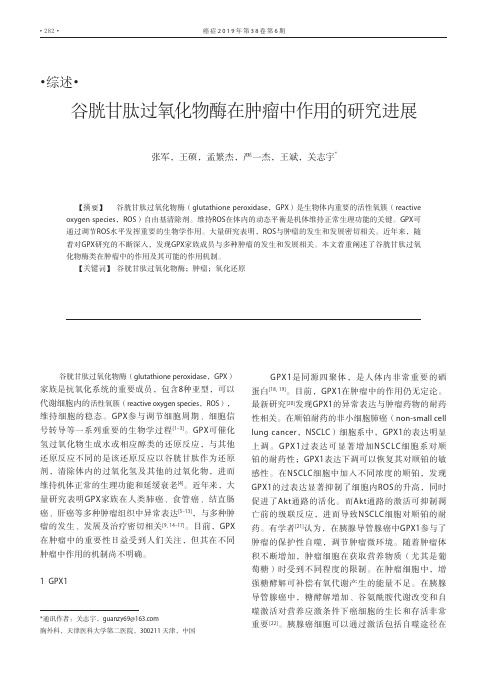
*通讯作者:关志宇,guanzy69@胸外科,天津医科大学第二医院,300211 天津,中国谷胱甘肽过氧化物酶在肿瘤中作用的研究进展张军,王硕,孟繁杰,严一杰,王斌,关志宇*•综述•【摘要】 谷胱甘肽过氧化物酶(glutathione peroxidase ,GPX )是生物体内重要的活性氧簇(reactive oxygen species ,ROS )自由基清除剂。
维持ROS 在体内的动态平衡是机体维持正常生理功能的关键。
GPX 可通过调节ROS 水平发挥重要的生物学作用。
大量研究表明,ROS 与肿瘤的发生和发展密切相关。
近年来,随着对GPX 研究的不断深入,发现GPX 家族成员与多种肿瘤的发生和发展相关。
本文着重阐述了谷胱甘肽过氧化物酶类在肿瘤中的作用及其可能的作用机制。
【关键词】 谷胱甘肽过氧化物酶;肿瘤;氧化还原谷胱甘肽过氧化物酶(glutathione peroxidase ,GPX )家族是抗氧化系统的重要成员,包含8种亚型,可以代谢细胞内的活性氧簇(reactive oxygen species ,ROS ),维持细胞的稳态。
GPX 参与调节细胞周期、细胞信号转导等一系列重要的生物学过程[1–3]。
GPX 可催化氢过氧化物生成水或相应醇类的还原反应,与其他还原反应不同的是该还原反应以谷胱甘肽作为还原剂,清除体内的过氧化氢及其他的过氧化物,进而维持机体正常的生理功能和延缓衰老[4]。
近年来,大量研究表明GPX 家族在人类肺癌、食管癌、结直肠癌、肝癌等多种肿瘤组织中异常表达[5–13],与多种肿瘤的发生、发展及治疗密切相关[9, 14–17]。
目前,GPX 在肿瘤中的重要性日益受到人们关注,但其在不同肿瘤中作用的机制尚不明确。
1 GPX1GPX1是同源四聚体,是人体内非常重要的硒蛋白[18, 19]。
目前,GPX1在肿瘤中的作用仍无定论。
最新研究[20]发现GPX1的异常表达与肿瘤药物的耐药性相关。
活性氧在热化疗抑制人肺肿瘤细胞生长中的作用

gop ,w i ol eihb e yN C ( <00 ) hshrltno N a s nf at cesdi te ru s hc cudb ii db A P h n t .5 ;P op oyao f K w s i icnl i r e h i J g i yn a n
te oc e o eaygop ad dcesd i S 6 0 2 n A ru s ( <00 ) P op o ltn o k h r —h m t rp ru n erae n P 0 15 ad N C gop P m h .5 ; hshr ao f t y i A
关键词 肺肿瘤 ; H 4 4 6细 胞 ; R S 热 疗 ; 凋 亡 O ;
I v l e n f ROS i y e g s c ef c f t e m o h r p n c m b n to t h mo h r p n h m a n o v me t o n s n r it fe t o h r t e a y i o i i a n wih c e t e a y o u n i
【 bt c】 o jcv T uy h o ie e ai s fnit y fco t roce o e p n A s at r bet e o t epsb c n m h ir eetfh m ・ m t r y i sd t s l m h s o i bo e h ha o
氧化应激与肿瘤发生发展

氧化应激与肿瘤发生发展摘要】氧化应激是近年来关于肿瘤形成及影响因素研究热点,氧化应激损通过细胞新邵转导途径,影响细胞基因表达,其产物可促进细胞的增殖分化,最终将导致细胞凋亡减少,甚至过度增殖从而引发肿瘤。
本文通过探讨氧化应激损伤在肿瘤发生、发展中的作用,并结合抗氧化治疗在肿瘤治疗中的作用,揭示肿瘤防治的一新思路。
【关键词】肿瘤活性氧分期【中图分类号】R73-3 【文献标识码】A 【文章编号】2095-1752(2014)05-0074-02英国Harmna教授在其于1956年初次提出的自由基衰老学说中指出,活性自由基打击生物体内大分子物质如蛋白质、脂类、核苷酸等从而引起组织损伤甚至细胞坏死是引起机体衰老的根本原因之一,这也肿瘤及其他一系列疾病发生的重大起因[1]。
然而,自由基衰老学说在众多学者的进一步研究验证中发现了众多缺陷,其一重大缺陷即此学说片面的注重了自由基对人体产生的有害作用而忽视了其在机体内发挥的重要有意作用。
1990年美国机体衰老机制研究权威Sohal RS教授和Allen RG教授提出了氧化紧张衰老学说,并在学说中首先阐述了氧化应激这一新概念[2]。
氧化应激是指生物体细胞在遇到种种应激刺激时,机体内产生高水平高活性物质,如活性氧、氮自由基等,从而导致机体内氧化-还原反应速率失衡,而各种氧化物导致的一体化氧化速度超出了机体抗氧化能力,最终结果导致氧化应激损伤人体组织。
氧化应激的本质即体内氧化-抗氧化系统的失衡。
[3]1 氧化应激损伤在肿瘤的发生发展中的作用在一般生理条件下,细胞内有高效的氧化-还原体系来调节高活性物质的浓度,以此防止氧化水平过高所能够引起的氧化损伤,例如在过氧化氢在产生的同时,机体细胞将分泌一定浓度的过氧化氢酶和谷胱甘肽过氧化物酶,进而恰好的促进其代谢[4]。
但在病理条件下,这个氧化-还原体系的均衡就会被打破,其后果就致使高活性物质的产生速率超出了机体抗氧化调节能力的范围,最后就导致了对机体的氧化应激损伤。
活性氧(ROS):肿瘤进展的双刃剑
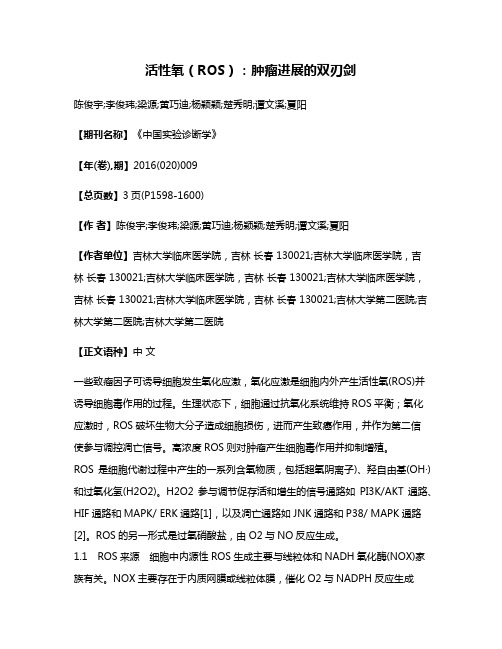
活性氧(ROS):肿瘤进展的双刃剑陈俊宇;李俊玮;梁源;黄巧迪;杨颖颖;楚秀明;谭文溪;夏阳【期刊名称】《中国实验诊断学》【年(卷),期】2016(020)009【总页数】3页(P1598-1600)【作者】陈俊宇;李俊玮;梁源;黄巧迪;杨颖颖;楚秀明;谭文溪;夏阳【作者单位】吉林大学临床医学院,吉林长春 130021;吉林大学临床医学院,吉林长春 130021;吉林大学临床医学院,吉林长春 130021;吉林大学临床医学院,吉林长春 130021;吉林大学临床医学院,吉林长春 130021;吉林大学第二医院;吉林大学第二医院;吉林大学第二医院【正文语种】中文一些致瘤因子可诱导细胞发生氧化应激,氧化应激是细胞内外产生活性氧(ROS)并诱导细胞毒作用的过程。
生理状态下,细胞通过抗氧化系统维持ROS平衡;氧化应激时,ROS破坏生物大分子造成细胞损伤,进而产生致癌作用,并作为第二信使参与调控凋亡信号。
高浓度ROS则对肿瘤产生细胞毒作用并抑制增殖。
ROS是细胞代谢过程中产生的一系列含氧物质,包括超氧阴离子)、羟自由基(OH·)和过氧化氢(H2O2)。
H2O2参与调节促存活和增生的信号通路如PI3K/AKT通路、HIF通路和MAPK/ ERK通路[1],以及凋亡通路如JNK通路和P38/ MAPK通路[2]。
ROS的另一形式是过氧硝酸盐,由O2与NO反应生成。
1.1 ROS来源细胞中内源性ROS生成主要与线粒体和NADH氧化酶(NOX)家族有关。
NOX主要存在于内质网膜或线粒体膜,催化O2与NADPH反应生成O2-。
O2-被呼吸链复合体Ⅰ、Ⅱ和Ⅲ以“电子漏”的形式释放入线粒体基质,进而被超氧化物歧化酶2(SOD2)转化为H2O2。
O2-穿过电压依赖性阴离子通道(VDAC)进入细胞质,自发或由SOD1转化为H2O2[3]。
另外,细胞色素P450、脂加氧酶(LOX)、环加氧酶(COX)和黄嘌呤氧化酶(XO)也可催化ROS生成[4]。
放疗促进肿瘤转移的研究进展

•综述•放疗促进肿瘤转移的研究进展曹玉霖I殷媛I李杰2周乐源''江南大学附属医院肿瘤研究所,无锡214062;2江南大学附属医院介入科,无锡214062通信作者:周乐源,Email:zhouleyuan99@【摘要】肿瘤细胞从原发病灶迁移到远处部位形成转移病灶的过程增加了患者的病死率放疗可通过电离直接或通过产生活性氧间接导致DNA损伤.从而杀死肿瘤细胞然而,近年来的研究结果表明,放疗诱导的肿瘤微环境变化在某些情况下可促进肿瘤转移而导致治疗失败.放疗后肿瘤微环境变化与肿瘤转移的关系受到广泛关注,但其机制尚不明确。
笔者对放疗如何通过诱导细胞因子表达、缺氧、整合素表达水平升高以及外泌体变化等因素从而促进肿瘤的转移进行综述。
【关键词】放射疗法;肿瘤微环境;肿瘤转移基金项目:国家自然科学基金青年科学基金项目(81301920);无锡市医学重点人才项目(ZDRC013)DOI:10.3760/121381-201907024-00068Research progress of radiotherapy-induced tumor metastasisCao Yulin1,Yin Yuan',Li Jie2,Zhou Leyuan'‘Oncology Institute,the Affiliated Hospital of J iangnan University,Wuxi214062,China;'Departmentof I ntet^ventional,the Affiliated Hospital of J iangnan University,Wuxi214062,ChinaCorresponding author:Zhou Leyuan,Email:zhouleyuan99@[Abstract]The process of tumor cells migrating from the primary lesion to distant sites to formmetastatic lesions in c reases the mortality of patients.Radiotherapy can cause DNA damage directlythrough ionization or indirectly through the production of reactive oxygen species,thereby destroyingtumor cells.However,recent studies have shown that radiotherapy-induced changes in tumormicroenvironment can promote tumor metastasis and cause treatment failure in some cases.Therelationship between tumor microenvironment changes after radiotherapy and tumor metastasis hasreceived widespread attention,but the mechanism remains unclear.This review discusses howradiotherapy promotes tumor metastasis by inducing cytokine expression,hypoxia,increased integrinexpression and changes in exosome.[Key words]Radiotherapy;Tumor microenvironment;Neoplasm metastasisFund program:National Natural Science Foundation of China Youth Science Fund Project(81301920);Wuxi Medical Key Talent Project(ZDRC013)DOI:10.3760/121381-201907024-00068肿瘤转移是指恶性肿瘤细胞从原发部位经淋巴道、血管或体腔等途径.到达其他部位继续生长的过程。
细胞活性氧对于免疫反应和疾病发生的影响
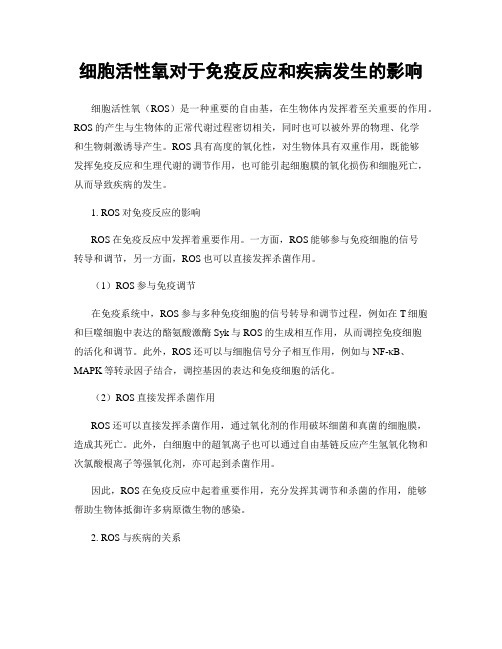
细胞活性氧对于免疫反应和疾病发生的影响细胞活性氧(ROS)是一种重要的自由基,在生物体内发挥着至关重要的作用。
ROS的产生与生物体的正常代谢过程密切相关,同时也可以被外界的物理、化学和生物刺激诱导产生。
ROS具有高度的氧化性,对生物体具有双重作用,既能够发挥免疫反应和生理代谢的调节作用,也可能引起细胞膜的氧化损伤和细胞死亡,从而导致疾病的发生。
1. ROS对免疫反应的影响ROS在免疫反应中发挥着重要作用。
一方面,ROS能够参与免疫细胞的信号转导和调节,另一方面,ROS也可以直接发挥杀菌作用。
(1)ROS参与免疫调节在免疫系统中,ROS参与多种免疫细胞的信号转导和调节过程,例如在T细胞和巨噬细胞中表达的酪氨酸激酶Syk与ROS的生成相互作用,从而调控免疫细胞的活化和调节。
此外,ROS还可以与细胞信号分子相互作用,例如与NF-κB、MAPK等转录因子结合,调控基因的表达和免疫细胞的活化。
(2)ROS直接发挥杀菌作用ROS还可以直接发挥杀菌作用,通过氧化剂的作用破坏细菌和真菌的细胞膜,造成其死亡。
此外,白细胞中的超氧离子也可以通过自由基链反应产生氢氧化物和次氯酸根离子等强氧化剂,亦可起到杀菌作用。
因此,ROS在免疫反应中起着重要作用,充分发挥其调节和杀菌的作用,能够帮助生物体抵御许多病原微生物的感染。
2. ROS与疾病的关系尽管ROS在正常的生物代谢过程中起着一定的调节功能,但是当ROS水平过高或者清除功能受到抑制时,就会引起细胞膜的氧化损伤和细胞死亡,导致许多疾病的发生。
(1)ROS与心血管疾病一系列研究表明,ROS与心血管疾病的发生密切相关。
ROS可以通过氧化剂的作用,导致胆固醇脂质的氧化,进而促进动脉粥样硬化的发生。
同时,ROS还可以直接损伤心肌细胞并加快心脏衰竭的进程。
(2)ROS与癌症在癌症的发生和发展过程中,ROS起着重要的作用。
某些癌细胞的生长需要较高的ROS水平,而ROS也可以通过调节转录因子及信号分子,促进癌细胞生长、侵袭和转移。
活性氧在肿瘤坏死因子信号传导中的作用

活性氧在肿瘤坏死因子信号传导中的作用
王志忠;鲁华玉;崔玉芳
【期刊名称】《科学技术与工程》
【年(卷),期】2004(004)001
【摘要】肿瘤坏死因子α(TNF-α)是最强的细胞内信号诱导剂之一.它通过对半胱氨酸蛋白酶家族(caspases)、丝裂原激活的蛋白激酶(MAPK)、c-iun N端激酶(JNK)、核转录因子AP-1和NF-κB的活化,可诱导细胞凋亡、分化和基因转录.此外,TNF也可通过调节细胞的还原状态,特别是内源性活性氧的改变来介导细胞内的信号.综述了ROS在TNF所诱导细胞内信号传导的相关内容,以阐述ROS介导TNF在细胞内信号传导及调节细胞的存活和凋亡中的作用.
【总页数】5页(P49-53)
【作者】王志忠;鲁华玉;崔玉芳
【作者单位】军事医学科学院放射医学研究所放射病实验治疗研究室,北京,100850;军事医学科学院放射医学研究所放射病实验治疗研究室,北京,100850;军事医学科学院放射医学研究所放射病实验治疗研究室,北京,100850
【正文语种】中文
【中图分类】Q279
【相关文献】
1.肿瘤坏死因子受体相关因子的信号传导通路及其在牙尖形成中的作用 [J], 辛蔚妮;凌均棨
2.肿瘤坏死因子α信号传导通路在儿童哮喘发病机制中的作用 [J], 齐玲;王玮瑶;张艳春;蔡尚霞;杨宁江;刘晓丽
3.脂筏在肿瘤坏死因子受体超家族信号传导途径中的作用 [J], 张伟伦;李明;刘彦信;郑德先
4.活性氧对植物防卫信号传导的作用探讨 [J], 李红玉;何晨阳
5.脂多糖诱导大鼠心肌细胞肿瘤坏死因子-α表达时活性氧调控的作用 [J], 尚福军;赵连友;郑强荪;王捷频;张丽娟;刘慧;刘少伟
因版权原因,仅展示原文概要,查看原文内容请购买。
香豆素类化合物抗肿瘤机制的研究进展

香豆素类化合物抗肿瘤机制的研究进展黄思思1周芊芊1罗婷1谢伟全1,2(1. 南华大学药学院 衡阳 421001;2. 桂林医学院药学院 桂林 541001)摘 要香豆素类化合物是传统的中草药成分,在自然界中普遍存在。
近年来,其抗肿瘤作用得到了广泛的关注。
研究表明,香豆素类化合物可通过诱导肿瘤细胞凋亡、阻滞细胞分裂周期、抑制肿瘤血管生成及肿瘤细胞迁移和侵袭、抗氧化以及调控多种蛋白和酶的活性等机制发挥抗肿瘤作用。
本文综述了近年来香豆素类化合物抗肿瘤机制的研究进展,以期为香豆素类化合物的进一步研究和开发提供理论基础和依据。
关键词香豆素 抗肿瘤 机制中图分类号:R965 文献标志码:A 文章编号:1006-1533(2022)01-0070-05Research progress in anti-cancer mechanism of coumarinsHUANG Sisi1, ZHOU Qianqian1, LUO Ting1, XIE Weiquan1,2(1. School of Pharmacy, University of South China, Hengyang 421001, China;2. School of Pharmacy, Guilin Medical University, Guilin 541001, China)ABSTRACT Coumarins are traditional herbal ingredients that are commonly found in nature. In recent years, their anti-tumor effects have received widespread attention. Researches have shown that coumarins exert anti-tumor effects through inducing apoptosis, blocking cell cycle, inhibiting tumor angiogenesis, tumor cell migration and invasion and antioxidation, and regulating the activities of various proteins and enzymes. This article reviews the recent research progress in the anti-tumor mechanism of coumarins so as to provide theoretical basis for the further research and development of coumarins.KEy wORDS coumarins; anti-tumor; mechanism据全球最新统计数据显示,2020年全球约有1 930万例新增癌症病例和近1 000万例癌症死亡病例[1],癌症的发病率和死亡率逐年上升,已成为威胁人类健康的主要原因之一。
活性氧与肿瘤
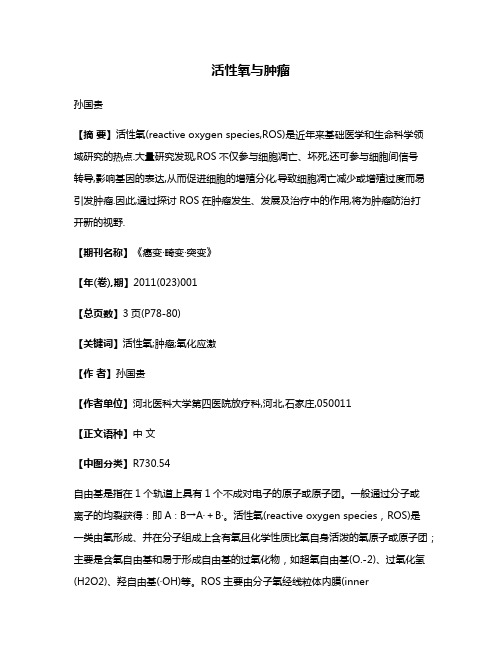
活性氧与肿瘤孙国贵【摘要】活性氧(reactive oxygen species,ROS)是近年来基础医学和生命科学领域研究的热点.大量研究发现,ROS不仅参与细胞凋亡、坏死,还可参与细胞间信号转导,影响基因的表达,从而促进细胞的增殖分化,导致细胞凋亡减少或增殖过度而易引发肿瘤.因此,通过探讨ROS在肿瘤发生、发展及治疗中的作用,将为肿瘤防治打开新的视野.【期刊名称】《癌变·畸变·突变》【年(卷),期】2011(023)001【总页数】3页(P78-80)【关键词】活性氧;肿瘤;氧化应激【作者】孙国贵【作者单位】河北医科大学第四医院放疗科,河北,石家庄,050011【正文语种】中文【中图分类】R730.54自由基是指在1个轨道上具有1个不成对电子的原子或原子团。
一般通过分子或离子的均裂获得:即A∶B→A·+B·。
活性氧(reactive oxygen species,ROS)是一类由氧形成、并在分子组成上含有氧且化学性质比氧自身活泼的氧原子或原子团;主要是含氧自由基和易于形成自由基的过氧化物,如超氧自由基(O.-2)、过氧化氢(H2O2)、羟自由基(·OH)等。
ROS主要由分子氧经线粒体内膜(innermitochondrial membrane,IMM)呼吸链复合体Ⅰ(NADH/biquinone oxidoreductase)及复合体Ⅲ(ubiquinol/cytochrome c oxidoreductase)传递产生[1]。
在正常的生理情况下,约有2%的氧消耗在线粒体,用于生成ROS[2]。
除线粒体外,其它内源性产生途径还有一氧化氮合成酶(NOS),细胞色素P450(Cyto P450),NADPH氧化酶(NOX),脂加氧酶(LOX),环加氧酶(COX),黄嘌呤氧化酶(XO)等[3];而外源性ROS产生途径主要包括电离辐射、金属离子、佛波醇酯类、氯化合物及细菌感染等。
活性氧与肿瘤关系的研究进展

活性氧与肿瘤关系的研究进展李瑾综述,刘炯审校[摘要]活性氧(ROS)主要是细胞线粒体电子传递链产生的一些性质活泼的含氧物质。
肿瘤相关基因可能会诱导活性氧的产生,继而激活与肿瘤发生发展相关的信号通路。
ROS因为浓度的不同,对细胞也具有不同的作用。
肿瘤细胞出现原因是细胞在分裂、增殖的过程中基因发生突变,ROS则会促进这一过程。
而细胞死亡的原因是ROS导致细胞DNA、蛋白质、脂质的损伤。
文章主要从ROS的生成与清除、ROS的致癌作用、ROS的抑癌作用等方面进行综述。
[关键词]活性氧;肿瘤;凋亡[中图分类号]R73[文献标志码]A[文章编号]1672-271X(2019)03-0297-05[DOI]10.3969/j.issn.1672-271X.2019.03.016Progress study of reactive oxygen species and tumorLI Jin1reviewing,LIU Jiong2checking(1.Bengbu Medical College,Bengbu233003,Anhui,China;2.Department of Gastroenterology,General Hospital of Eastern Theater Command,PLA,Nanjing210002,Jiangsu,China)[Abstract]Reactive oxygen species(ROS)is the general name for the active oxygen metabolites that the mainly production from electron transport chain.Tumor-associated genes may induce the production of ROS,which in turn activate the signal pathways involved in tumor development.ROS promotes cell mitosis and proliferation,increases genomic instability and induces tumorigenesis and development.However,the high concentration of ROS causes the damage of DNA,protein and lipid,eventually leading to cell death.This article reviews the generation and clearance,the carcinogenic effect,and the anti-cancer effect of ROS.[Key words]reactive oxygen species;tumor;apoptosis0引言活性氧(reactive oxygen species,ROS)是包含氧分子(dioxygen,O2)、超氧阴离子(superoxide anion,O-2)、过氧化氢(hydrogen peroxide,H2O2)、羟自由基(hydroxyl radical,HO•)等性质活泼的物质,主要来源于细胞线粒体电子传递链。
线粒体氧化应激与肿瘤的研究进展

世界最新医学信息文摘 2021年第21卷第23期101投稿邮箱:sjzxyx88@·综述·线粒体氧化应激与肿瘤的研究进展韩晓丹1,黄国锦1,2(通信作者*)(1.桂林医学院附属医院呼吸疾病实验室,广西 桂林 541000;2. 桂林医学院广西肝损伤与修复分子医学重点实验室,广西 桂林 541000;)摘要:线粒体在肿瘤生物能学中起关键作用,被认为是抗肿瘤治疗的潜在靶标。
线粒体产生的活性氧(reactive oxygen species, ROS )在生理浓度时,是维持生命活动的主要介质,但在病理状态下,其浓度升高后可打破抗氧化保护机制的平衡,导致氧化应激的发生。
氧化应激可以引起细胞的损伤,从而参与包括肿瘤在内的一些与细胞损伤和死亡相关的疾病。
本文将从线粒体氧化应激通过调控细胞信号传导通路、与腺苷酸活化蛋白激酶(AMP-activated protein kinase, AMPK )相互作用及调节自噬等方面,系统讨论线粒体氧化应激在肿瘤发生发展中的作用,进一步讨论线粒体氧化应激与肿瘤的治疗之间的关系并作一综述。
关键词:线粒体;氧化应激;活性氧;肿瘤中图分类号:R73 文献标识码:A DOI :10.3969/j.issn.1671-3141.2021.23.035本文引用格式:韩晓丹,黄国锦.线粒体氧化应激与肿瘤的研究进展[J].世界最新医学信息文摘,2021,21(23):101-103.Research Progress of Mitochondrial Oxidative Stress and TumorHAN Xiao-dan 1,HUANG Guo-jin 1,2*(1. Laboratory of Respiratory Diseases, the Affiliated Hospital of Guilin Medical University, Guilin Guangxi 541000; 2. GuangxiKey Laboratory of Molecular Medicine in Liver Injury and Repair, Guilin Medical University, Guilin Guangxi 541000)ABSTRACT: Mitochondria play a key role in tumor bioenergetics and are considered as potential targets for anti-tumor therapy. Mitochondrial metabolites, especially reactive oxygen species (ROS), are the main mediators for maintaining life activities at physiological concentrations. However, under pathological conditions, an increase in the concentration of reactive oxygen species breaks the balance of antioxidant protection mechanisms, which will cause oxidative stress. Oxidative stress can cause cell damage and participate in some diseases related to cell injury and death, including tumors. This article will systematically discuss the role of mitochondrial oxidative stress in tumorigenesis and development from the aspects of regulating cell signal transduction pathway, interacting with adenylate activated protein kinase (AMPK) and regulating autophagy, and further discuss the relationship between mitochondrial oxidative stress and tumor treatment.KEY WORDS: mitochondria; oxidative stress; reactive oxygen species; tumor0 引言在正常的生理情况下,细胞主要依靠葡萄糖进入细胞后通过有氧氧化和无氧酵解产生ATP 来供能[1,2]。
NOX-1基因及其在恶性肿瘤中的作用和分子机制

NOX-1基因及其在恶性肿瘤中的作用和分子机制徐国利【摘要】NADPH氧化酶-1(NADPH oxidase-1,NOX-1)是NADPH氧化酶(nicotinamide adenine dinucleotide phosphate oxidase,NADPH oxidase,NOX)家族成员之一.NOX是调节体内氧化还原反应的关键酶,也是最早被确认的产生活性氧类(reactive oxygen species,ROS)的体系.一方面,少量的ROS 可增强免疫防御,参与细胞分化、增殖、凋亡及细胞间信号通路的调控;另一方面,过多的ROS可引起氧化应激,致使细胞生理功能紊乱,对加速炎症、纤维化和肿瘤形成等病理过程起着重要作用.作为ROS主要来源之一,NOX-1在肿瘤形成过程中扮演重要角色.本文综述NOX-1及其在肿瘤中的作用和分子机制研究进展,以期探寻胆囊癌等恶性肿瘤诊治和预后判断的有效靶标.【期刊名称】《外科研究与新技术》【年(卷),期】2017(006)004【总页数】5页(P276-280)【关键词】NADPH氧化酶-1;活性氧类;肿瘤;胆囊癌【作者】徐国利【作者单位】同济大学附属同济医院普外科,上海200065【正文语种】中文【中图分类】R735.8NADPH氧化酶-1(NADPH oxidase-1,NOX-1)是NADPH氧化酶(nicotinamide adenine dinucleo-tide phosphate oxidase,NADPH oxidase,NOX)家族成员之一。
NOX是细胞内一组具有氧化活性的蛋白[1],是由膜亚基gp91phox(即NOX-2)和跨膜亚基p22phox,胞浆亚基p47phox、p67phox、p40phox和小分子GTPase结合蛋白Rac 等组成的酶复合体[2-4]。
还原型烟酰胺腺嘌呤二核苷酸磷酸(nicotinamide adenine dinucleotide phosphate,NADPH)即还原型辅酶Ⅱ,在很多生物体化学反应中起着递氢体的作用,对机体具有重要意义。
活性氧调控巨噬细胞极化的研究进展
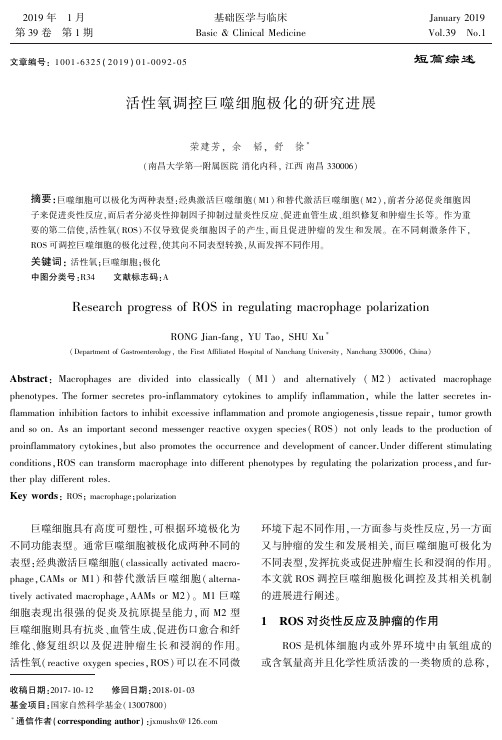
2019年㊀1月第39卷㊀第1期基础医学与临床Basic&ClinicalMedicineJanuary2019Vol.39㊀No.1收稿日期:2017 ̄10 ̄12㊀㊀修回日期:2018 ̄01 ̄03基金项目:国家自然科学基金(13007800)∗通信作者(correspondingauthor):jxmushx@126.com文章编号:1001 ̄6325(2019)01 ̄0092 ̄05短篇综述㊀活性氧调控巨噬细胞极化的研究进展荣建芳ꎬ余㊀韬ꎬ舒㊀徐∗(南昌大学第一附属医院消化内科ꎬ江西南昌330006)摘要:巨噬细胞可以极化为两种表型:经典激活巨噬细胞(M1)和替代激活巨噬细胞(M2)ꎬ前者分泌促炎细胞因子来促进炎性反应ꎬ而后者分泌炎性抑制因子抑制过量炎性反应㊁促进血管生成㊁组织修复和肿瘤生长等ꎮ作为重要的第二信使ꎬ活性氧(ROS)不仅导致促炎细胞因子的产生ꎬ而且促进肿瘤的发生和发展ꎮ在不同刺激条件下ꎬROS可调控巨噬细胞的极化过程ꎬ使其向不同表型转换ꎬ从而发挥不同作用ꎮ关键词:活性氧ꎻ巨噬细胞ꎻ极化中图分类号:R34㊀㊀文献标志码:AResearchprogressofROSinregulatingmacrophagepolarizationRONGJian ̄fangꎬYUTaoꎬSHUXu∗(DepartmentofGastroenterologyꎬtheFirstAffiliatedHospitalofNanchangUniversityꎬNanchang330006ꎬChina)Abstract:Macrophagesaredividedintoclassically(M1)andalternatively(M2)activatedmacrophagephenotypes.Theformersecretespro ̄inflammatorycytokinestoamplifyinflammationꎬwhilethelattersecretesin ̄flammationinhibitionfactorstoinhibitexcessiveinflammationandpromoteangiogenesisꎬtissuerepairꎬtumorgrowthandsoon.Asanimportantsecondmessengerreactiveoxygenspecies(ROS)notonlyleadstotheproductionofproinflammatorycytokinesꎬbutalsopromotestheoccurrenceanddevelopmentofcancer.UnderdifferentstimulatingconditionsꎬROScantransformmacrophageintodifferentphenotypesbyregulatingthepolarizationprocessꎬandfur ̄therplaydifferentroles.Keywords:ROSꎻmacrophageꎻpolarization㊀㊀巨噬细胞具有高度可塑性ꎬ可根据环境极化为不同功能表型ꎮ通常巨噬细胞被极化成两种不同的表型:经典激活巨噬细胞(classicallyactivatedmacro ̄phageꎬCAMsorM1)和替代激活巨噬细胞(alterna ̄tivelyactivatedmacrophageꎬAAMsorM2)ꎮM1巨噬细胞表现出很强的促炎及抗原提呈能力ꎬ而M2型巨噬细胞则具有抗炎㊁血管生成㊁促进伤口愈合和纤维化㊁修复组织以及促进肿瘤生长和浸润的作用ꎮ活性氧(reactiveoxygenspeciesꎬROS)可以在不同微环境下起不同作用ꎬ一方面参与炎性反应ꎬ另一方面又与肿瘤的发生和发展相关ꎬ而巨噬细胞可极化为不同表型ꎬ发挥抗炎或促进肿瘤生长和浸润的作用ꎮ本文就ROS调控巨噬细胞极化调控及其相关机制的进展进行阐述ꎮ1㊀ROS对炎性反应及肿瘤的作用ROS是机体细胞内或外界环境中由氧组成的或含氧量高并且化学性质活泼的一类物质的总称ꎬ荣建芳㊀活性氧调控巨噬细胞极化的研究进展细胞内的ROS主要来自过氧化氢(H2O2)㊁超氧阴离子(O2 -)㊁羟基自由基(.OH)ꎮ在炎性反应的病灶部位ꎬ巨噬细胞和中性粒血细胞聚集并生成大量ROSꎬ引发促炎细胞因子的产生ꎬ对细胞中的许多分子(包括膜脂质㊁蛋白质和核酸)造成氧化损伤ꎮROS持续产生ꎬ细胞结构和功能可能会发生显著的损伤ꎬ并诱发体细胞突变和肿瘤转化ꎬ而且ROS还可以通过对DNA的直接氧化损伤ꎬ诱导脂质过氧化或氧化蛋白损伤ꎬ导致DNA的结构改变ꎬ从而促进肿瘤发展ꎮ线粒体形成的O2 -及其歧化产物H2O2参与亚砷酸盐引起的DNA损伤[1]ꎮROS倾向于诱导P53功能丧失ꎬ导致DNA修复缺陷ꎬ导致DNA损伤的积累ꎬ从而促进肿瘤发生和进展ꎮ因此ꎬ细胞内ROS对炎性反应及肿瘤的发生及发展可能发挥重要作用ꎮ2㊀巨噬细胞极化的表型及其功能巨噬细胞参与先天性和适应性免疫㊁血管生成㊁增殖甚至恶性肿瘤的形成ꎮ实际上ꎬ巨噬细胞可以在不同的环境中分化为两个不同的亚型:M1巨噬细胞和M2巨噬细胞ꎮM1巨噬细胞由Th1细胞因子诱导ꎬ如干扰素 ̄γ(IFN ̄γ)㊁脂多糖(LPS)和粒细胞 ̄巨噬细胞集落刺激因子ꎬ分泌白介素(IL) ̄6㊁诱导型一氧化氮合酶(iNOS)和肿瘤坏死因子 ̄α(TNF ̄α)等促炎因子ꎬ以及CD80和CD86等ꎬ主要发挥促炎活性ꎬ在抗菌和抗感染中发挥重要作用ꎮ相比之下ꎬTh2细胞因子诱导M2巨噬细胞产生ꎬ如IL ̄4㊁IL ̄13㊁IL ̄10㊁转化生长因子 ̄β(TGF ̄β)等ꎬM2巨噬细胞在组织损伤修复以及促进肿瘤细胞增殖等方面发挥作用ꎬ表达高水平的CD163和CD206ꎬ以及精氨酸酶1(arginine1ꎬArg1)㊁趋化因子(chemokinesꎬCCL)17和CCL22等ꎮ巨噬细胞表型向M1或M2极化可能导致如肥胖症㊁癌和类风湿性关节炎等疾病的发生ꎮ3㊀ROS对巨噬细胞极化的调控及其机制巨噬细胞的极化是一个多因子相互作用的复杂过程ꎬ受到多种信号分子及其通路的调控ꎬ各种因素可能影响组织内巨噬细胞的主要表型ꎮ在不同微环境下ꎬROS通过多种信号分子及其通路调控巨噬细胞的极化ꎬ参与炎性反应及肿瘤的发生及发展过程ꎮ3 1㊀ROS与M1巨噬细胞巨噬细胞是机体固有免疫系统的重要成分之一ꎬM1巨噬细胞具有高杀菌功能ꎬ防御病原体入侵是M1的主要功能ꎮ手术伤口中的高氧分压增加了与杀菌宿主防御相关的ROS的产生ꎬ增强了机体抗细菌感染的能力[2]ꎮ还原型辅酶Ⅱ(NADPH)氧化酶(NOX)蛋白家族是ROS和氧化应激的主要来源ꎬ这种酶有几种异构体ꎬ即NOX1㊁NOX2㊁NOX3㊁NOX4㊁NOX5㊁双氧化酶(DUOX)1和DUOX2ꎮ活化NOX2可以转化为其他超氧化物衍生的氧化剂ꎬ如H2O2㊁羟基和过氧亚硝酸盐ꎬ而NOX4直接产生H2O2ꎮ这些ROS具有严重的细胞毒性作用ꎬ通过激活丝裂原活化蛋白激酶(mitogen ̄activatedproteinki ̄nasesꎬMAPKs)和核因子 ̄κB(NF ̄κB)信号促进炎性反应过程ꎬ最终诱导促炎细胞因子和其他炎性介质如TNF ̄α㊁iNOS和单核细胞趋化蛋白的转录ꎮ变应原(FCN) ̄A/2可以增加MAPK/NF ̄κB信号的激活ꎬ促进RAW264 7细胞中M1巨噬细胞极化和促炎细胞因子的产生[3]ꎮ内源性产生的H2O2可以激活NF ̄κB促进RAW264 7细胞中M1巨噬细胞极化和促炎细胞因子的产生ꎮ作为模式识别受体的Toll样受体(Toll ̄likere ̄ceptorsꎬTLR)在调节炎性反应和维持炎性反应平衡方面发挥关键作用ꎮNF ̄κB是参与炎性反应的重要转录因子ꎬ控制促炎细胞因子的产生[4]ꎬTLR4的激活导致NF ̄κB的核转位ꎬ并调节与炎性反应相关的基因转录ꎬ如TNFα㊁IL ̄1β和ROS是通过上调巨噬细胞激酶级联来扩增炎性反应的第二信使ꎮ在免疫细胞中ꎬNADPH氧化酶产生的ROS对于TLR配体引起的病原体杀伤很重要ꎬLPS能够诱导ROS的释放[5]ꎬ并激活TLRꎬTLR4识别并结合LPSꎬ促进TLR4与髓样细胞分化蛋白(MyD88)的结合ꎬ巨噬细胞极化为M1表型ꎮ当LPS结合TLR4激活巨噬细胞时ꎬ巨噬细胞中NF ̄κB激活ꎬ引起炎性介质和细胞因子的转录和翻译ꎮ花青素混合物通过减少ROS产生和使NF ̄κB和STAT1/3失活ꎬ在巨噬细胞中发挥抗炎作用[6]ꎮPM2 5可以诱导ROS生成增加ꎬ增强LPS诱导的M1巨噬细胞极化ꎬ促进炎性细胞因子的释放ꎬ如TNFα及IL ̄6等ꎬ显著增强巨噬细胞炎性反应[7]ꎮ用N ̄乙酰半胱氨酸(N ̄acetylcyste ̄39基础医学与临床㊀㊀Basic&ClinicalMedicine2019 39(1)ineꎬNAC)或夹竹桃痳素抑制ROS产生及降低ROS水平可抑制LPS诱导的炎性反应[8]ꎮTRPM2(tran ̄sientreceptorpotentialmelastatin2)影响ROS和炎性细胞因子的产生ꎬ随后介导幽门螺杆菌感染期间胃黏膜炎性损伤[9]ꎮIFN ̄γ可以激活诱导ROS产生的酶(如NOX)ꎬ引起ROS的产生ꎬ导致炎性反应和氧化应激ꎮ远端缺血预处理(remoteischemicpreconditioningꎬRIPC)可通过激活Janus激酶(JanuskinaseꎬJAK)/信号传导物和转录激活物(signaltransducerandactivatoroftranscriptionꎬSTAT)途径增加细胞内NO和ROS的产生ꎬ最终抑制转录因子引起的早期生长反应蛋白 ̄1(earlygrowthresponse ̄1ꎬEgr ̄1)产生[10]ꎮIFN ̄γ通过JAK ̄STAT信号通路活化巨噬细胞ꎬ主要是激活STAT1ꎬ参与M1巨噬细胞的极化ꎬ从而增强巨噬细胞对微生物的杀伤能力与抗原提呈能力ꎬ并促进促炎细胞因子的分泌ꎮ铁显著抑制促炎细胞因子的转录和M1巨噬细胞中iNOS的产生ꎬ而这一过程涉及信号传导和STAT1通路的抑制[11]ꎮ依赖TLR3产生的ROS对于STAT1的活化是必需的ꎬ并且其增强炎性介质的释放ꎮ线粒体功能障碍增加ROS的产生ꎬ从而驱动I型IFN诱导的基因表达和肌肉炎性反应ꎬ引起皮肌炎[12]ꎮIFN ̄γ可以激活STAT1引起ROS的产生ꎬ促进巨噬细胞向M1极化ꎬ分泌促炎因子ꎬ引起机体的炎性反应ꎬ若阻断STAT1信号ꎬ或许能抑制M1巨噬细胞引起的炎性反应过程ꎮ3 2㊀ROS与M2巨噬细胞M2巨噬细胞有抑制炎性反应㊁促进组织重塑和伤口愈合的作用ꎬ促进肿瘤的生长㊁转移和抗肿瘤免疫抑制ꎮNOX1和NOX2的缺失导致巨噬细胞中ROS产生的急剧下降ꎬ并导致单核细胞对巨噬细胞分化和M2型巨噬细胞分化的功能受损ꎬ抑制ROS的产生减弱了M2的极化[13]ꎮ香烟提取物可降低细胞内ROS水平ꎬ诱导巨噬细胞M2极化ꎮ低水平ROS可以促进巨噬细胞M2极化ꎬ在伤口愈合过程中释放的H2O2是主要的ROS之一ꎬ氧化交联过程中产生的H2O2造成M2巨噬细胞的活化ꎮ虽然大量的ROS可能产生显著的组织损伤ꎬ但细胞内ROS水平ꎬ尤其是低水平的H2O2可以在信号传导中起关键作用ꎬ提供肿瘤细胞增殖和血管生成所必需增殖信号ꎬ也与促进肿瘤发生和进展的促炎状态密切相关ꎮ在相对低浓度下ꎬH2O2诱导血管内皮生长因子表达并激活M2型巨噬细胞分化ꎬ促进血管生成和组织再生ꎮ肿瘤相关巨噬细胞(tumor ̄associatedmacrophagesꎬTAMs)显示典型的M2巨噬细胞特性ꎬROS抑制剂丁基羟基茴香醚(butylatedhydroxyanisoleꎬBHA)连续给药ꎬ有效地阻断TAMs的发生ꎬ并显著抑制小鼠肿瘤模型中的肿瘤发生[14]ꎮNOX1和NOX2对巨噬细胞分化过程中MAPK㊁c ̄Jun氨基末端激酶(c ̄JunN ̄terminalkinaseꎬJNK)和细胞外调节蛋白激酶(ERK)的激活至关重要ꎬJNK和ERK活化的缺陷使单核细胞失去向巨噬细胞分化的能力ꎬ从而影响M2巨噬细胞的极化ꎮ活化的小GTP酶Rac1是一种已知的NOX1氧化酶激活剂ꎬRac1的敲除对M1巨噬细胞的分化没有影响ꎬ但有效阻断M2巨噬细胞分化ꎬ而且BHA通过抑制NOX介导的氧气代谢来阻断M2巨噬细胞的极化ꎮ另外ꎬ长期砷暴露可通过生成ROS将巨噬细胞极化为M2型ꎬROS抑制剂BHA的处理后ꎬ显著抑制了砷诱导的巨噬细胞向M2型活化ꎬM2型巨噬细胞所表达的CD206和CD163也随之降低[15]ꎮ细胞内外酸中毒时可诱导ROS形成ꎬ然后ROS能增强ERK1/2和p38MAPK磷酸化ꎬ促进M2巨噬细胞极化ꎮIL ̄4和IL ̄13诱导人平滑肌细胞中ERK磷酸化[16]ꎬ刺激巨噬细胞分化为M2巨噬细胞ꎮ激活ERK信号使巨噬细胞极化为促肿瘤的M2型ꎬ高密度的M2巨噬细胞与NSCLC患者的转移有关ꎮ葛根素通过抑制ERK核移位来抑制MEK/ERK1/2途径的活化ꎬ从而抑制了MEK/ERK1/2途径ꎬ故IL ̄4诱导的M2巨噬细胞极化和NSCLC的转移可被葛根素抵消[17]ꎮ乳腺癌的磷酸化mTOR(mamm ̄aliantargetofrapamycinꎬp ̄mTOR)ꎬ磷酸化ERK1/2(p ̄ERK1/2)和HIF ̄1α的表达显著增加ꎬ而自噬通过抑制p ̄mTOR和ROS/p ̄ERK1/2及其共同的下游信号分子pTyr705 ̄STAT3和低氧诱导因子 ̄1α(hy ̄poxiainduciblefactor ̄1ꎬHIF ̄1α)的表达ꎬ来减弱肿瘤微环境中的异丙肾上腺素诱导的M2巨噬细胞极化ꎬ然后发挥抗肿瘤作用[18]ꎮIL ̄4㊁IL ̄13和IL ̄10还可以通过JAK/STAT信号通路使巨噬细胞极化为M2表型ꎮ在含SH2的肌49荣建芳㊀活性氧调控巨噬细胞极化的研究进展醇 ̄5  ̄磷酸酶缺陷的巨噬细胞中ꎬIL ̄4诱导的M2巨噬细胞活化需要STAT6的活化[19]ꎮ在人肺腺癌细胞中ꎬJAK1/STAT6通路的活化可增加NOX1的转录ꎬIL ̄4可激活NOX1在几分钟内产生ROSꎮ用ROS抑制剂处理后ꎬ能减少IL ̄4诱导的STAT6活化ꎬ依赖NADPH产生的ROS减少ꎬ可能促进磷酸化STAT6的去磷酸化ꎬ从而减弱IL ̄13信号传导[20]ꎮ另外ꎬ含有高水平的铜(copperꎬCu)ꎬ锌(zincꎬZn) ̄超氧化物歧化酶(SOD)的肺泡巨噬细胞可极化为促纤维化的M2表型ꎬ并加速肺纤维化的发展ꎮ因为CuꎬZn ̄SOD诱导的H2O2可以将巨噬细胞极化为促纤维化的M2表型ꎬSTAT6以氧化还原方式介导CuꎬZn ̄SOD诱导的M2极化[21]ꎮ低水平的ROS可以使巨噬细胞M2极化ꎬ但显著抑制ROS的浓度会减弱巨噬细胞M2极化ꎬ这提示改变ROS的水平或许能影响肿瘤形成的微环境ꎬ抑制肿瘤的发展ꎬ这也许是肿瘤治疗的新靶点ꎮ4 结语综上所述ꎬ差异的微环境和信号通路可影响ROS的水平ꎬ在巨噬细胞极化过程可能发挥了双重作用ꎮ一方面ꎬ高浓度的ROS诱导巨噬细胞向M1型极化ꎬ促进炎性细胞因子的释放ꎬ发挥促炎作用ꎻ另一方面ꎬ低浓度的ROS可以调控巨噬细胞M2极化ꎬ抑制炎性反应ꎬ和肿瘤的发生和发展相关ꎮ目前ꎬ对于ROS如何调控巨噬细胞极化ꎬ使其转化为M1或M2表型ꎬ参与炎性反应或肿瘤的发生和发展过程ꎬ以及通过调节ROS的水平ꎬ调控M1巨噬细胞和M2巨噬细胞之间的相互转化ꎬ从而影响炎性反应和肿瘤之间的转归ꎬ仍有待深入研究ꎮ因此进一步了解ROS对巨噬细胞极化的相关机制ꎬ对于许多炎性疾病及肿瘤的发病及治疗方面具有重要的意义ꎮ参考文献:[1]GuidarelliAꎬFioraniMꎬCerioniLꎬetal.ArseniteinducesDNAdamageviamitochondrialROSandinductionofmitochondrialpermeabilitytransition[J].Bio ̄factorsꎬ2017ꎬ43:673 ̄684.[2]HafnerCꎬWuJꎬSoto ̄GonzalezLꎬetal.Moderatehyper ̄oxiainducesinflammationꎬapoptosisandnecrosisinhumanumbilicalveinendothelialcells:Anin ̄vitrostudy[J].EurJAnaesthesiolꎬ2017ꎬ34:141 ̄149. [3]YangYFꎬZhouYDꎬHuJCꎬetal.Ficolin ̄A/2ꎬactingasanewregulatorofmacrophagepolarizationꎬmediatestheinflammatoryresponseinexperimentalmousecolitis[J].Immunologyꎬ2017ꎬ151:433 ̄450. [4]LeeHWꎬLeeCGꎬRheeDKꎬetal.Sinigrininhibitspro ̄ductionofinflammatorymediatorsbysuppressingNF ̄kap ̄paB/MAPKpathwaysorNLRP3inflammasomeactivationinmacrophages[J].IntImmunopharmacolꎬ2017ꎬ45:163 ̄173.[5]ZhangQꎬDengYꎬLaiWꎬetal.MaternalinflammationactivatedROS ̄p38MAPKpredisposesoffspringtoheartdamagescausedbyisoproterenolviaaugmentingROSgen ̄eration[J].SciRepꎬ2016ꎬ6:30146.10.1038/srep30146.[6]LeeHHꎬLeeSGꎬShinJSꎬetal.p ̄Coumaroylantho ̄cya ̄ninmixtureisolatedfromtuberepidermisofsolanumtu ̄berosumattenuatesreactiveoxygenspeciesandpro ̄in ̄flammatorymediatorsbysuppressingNF ̄kappaBandSTAT1/3signalinginLPS ̄inducedRAW264 7macropha ̄ges[J].BiolPharmBullꎬ2017ꎬ40:1894 ̄1902. [7]ZhaoQꎬChenHꎬYangTꎬetal.DirecteffectsofairbornePM2.5exposureonmacrophagepolarizations[J].BiochimBiophysActaꎬ2016ꎬ1860:2835 ̄2843. [8]QiSꎬFengZꎬLiQꎬetal.MyricitrinmodulatesNADPHoxidase ̄dependentROSproductiontoinhibitendotoxin ̄mediatedinflammationbyblockingtheJAK/STAT1andNOX2/p47phoxpathways[J].OxidMedCellLongevꎬ2017ꎬ2017:9738745.10.1155/2017/9738745[9]BeceiroSꎬRadinJNꎬChatuvediRꎬetal.TRPM2ionchannelsregulatemacrophagepolarizationandgastricin ̄flammationduringHelicobacterpyloriinfection[J].MucosalImmunolꎬ2017ꎬ10:493 ̄507.[10]MudaliarHꎬRaynerBꎬBillahMꎬetal.RemoteischemicpreconditioningattenuatesEGR ̄1expressionfol ̄lowingmyocardialischemiareperfusioninjurythroughac ̄tivationoftheJAK ̄STATpathway[J].IntJCardiolꎬ2017ꎬ228:729 ̄741.[11]GanZSꎬWangQQꎬLiJHꎬetal.IronreducesM1macro ̄59基础医学与临床㊀㊀Basic&ClinicalMedicine2019 39(1)phagepolarizationinRAW264.7macrophagesassociatedwithinhibitionofSTAT1[J].MediatorsInflammꎬ2017ꎬ2017:8570818.10.1155/2017/8570818.[12]MeyerAꎬLavernyGꎬAllenbachYꎬetal.IFN ̄beta ̄in ̄ducedreactiveoxygenspeciesandmitochondrialdamagecontributetomuscleimpairmentandinflammationmainte ̄nanceindermatomyositis[J].ActaNeuropatholꎬ2017ꎬ134:655 ̄666.[13]OrsolicNꎬKunsticMꎬKukoljMꎬetal.Oxidativestressꎬpolarizationofmacrophagesandtumourangiogenesis:Ef ̄ficacyofcaffeicacid[J].ChemBiolInteractꎬ2016ꎬ256:111 ̄124.[14]ZhangYꎬChoksiSꎬChenKꎬetal.ROSplayacriticalroleinthedifferentiationofalternativelyactivatedmacro ̄phagesandtheoccurrenceoftumor ̄associatedmacro ̄phages[J].CellResꎬ2013ꎬ23:898 ̄914.[15]CuiJꎬXuWꎬChenJꎬetal.M2polarizationofmacro ̄phagesfacilitatesarsenic ̄inducedcelltransformationoflungepithelialcells[J].Oncotargetꎬ2017ꎬ8:21398 ̄21409.[16]GnanaprakasamJꎬEstrada ̄MunizEꎬVegaL.Theanac ̄ardic6 ̄pentadecylsalicylicacidinducesmacrophageacti ̄vationviathephosphorylationofERK1/2ꎬJNKꎬP38ki ̄nasesandNF ̄kappaB[J].IntImmunopharmacolꎬ2015ꎬ29:808 ̄817.[17]KangHꎬZhangJꎬWangBꎬetal.PuerarininhibitsM2polarizationandmetastasisoftumor ̄associatedmacro ̄pha ̄gesfromNSCLCxenograftmodelviainactivatingMEK/ERK1/2pathway[J].IntJOncolꎬ2017ꎬ50:545 ̄554. [18]ShanMꎬQinJꎬJinFꎬetal.Autophagysuppressesiso ̄prenaline ̄inducedM2macrophagepolarizationviatheROS/ERKandmTORsignalingpathway[J].FreeRadicBiolMedꎬ2017ꎬ110:432 ̄443.[19]HoVWꎬHofsEꎬElisiaIꎬetal.AlltransretinoicacidꎬtransforminggrowthfactorbetaandprostaglandinE2inmouseplasmasynergizewithbasophil ̄secretedinter ̄leukin ̄4toM2polarizemurinemacrophages[J].PLoSOneꎬ2016ꎬ11:e168072.doi:10.1371/journal.pone.0168072. [20]NagarajCꎬHaitchiHMꎬHeinemannAꎬetal.Increasedexpressionofp22phoxmediatesairwayhyperresponsivenessinanexperimentalmodelofasthma[J].AntioxidRedoxSignalꎬ2017ꎬ27:1460 ̄1472.[21]HeCꎬLarson ̄CaseyJLꎬGuLꎬetal.CuꎬZn ̄superoxidedismutase ̄mediatedredoxregulationofjumonjidomaincontaining3modulatesmacrophagepolarizationandpul ̄monaryfibrosis[J].AmJRespirCellMolBiolꎬ2016ꎬ55:58 ̄71.新闻点击预防老年人骨折及跌倒ꎬ运动比吃维生素D及钙更有效据英国«BBC新闻»(BBCNEWS)2018 ̄04 ̄12报道ꎬ一直以来ꎬ人们都相信补充维生素D及钙质可以强壮骨骼ꎬ预防骨折ꎮ美国预防服务工作组(USPSTF)最近更新他们有关补充维生素D(含或不含钙)的建议ꎬ对维生素D和钙补充剂的效果予以保留ꎬ并主张通过运动和其他措施来预防老年人骨折和跌倒ꎮUSPSTF新的建议指出ꎬ没有足够的证据来评估维生素D和钙补充剂预防男性和停经后妇女初次骨折的益处或危害ꎮ2012年的建议指出ꎬ维生素D可能可以预防跌倒ꎬ但2018年将此建议修订为不确定其效果ꎮ目前有中度的证据支持通过运动来预防65岁以上的成年人跌倒ꎮ低度的证据支持ꎬ针对可能增加跌倒风险的因素采取措施ꎬ包括:平衡感㊁步态㊁视力㊁药物使用㊁血压等因素ꎮ研究作者为这些建议提供了重要文献依据ꎬ并强调身体活动的重要性ꎮJoAnnManson博士认为ꎬ重新关注身体活动可能带来额外健康益处ꎬ包括:预防跌倒㊁因跌倒而引起的各种健康问题及改善整体健康ꎮ此外ꎬ新的建议希望有更多研究去了解高剂量的维生素D是否有助于防止跌倒和骨折ꎮ临床试验VITAL正对此主题进行研究ꎬ将在2019年公布结果ꎮ还有另一项大型临床试验STRIDE旨在了解针对可能增加跌倒风险的因素采取措施的有效性ꎮ刘晓荻㊀译王㊀欣㊀编69。
POX 与肿瘤抑制的研究进展

POX与肿瘤抑制的研究进展林增宝1△(综述),邢金春1,2※(审校)(1.福建医科大学第一临床医学院,福州350001;2.厦门市第一医院泌尿外科,福建厦门361003)中图分类号:R730.54 文献标识码:A 文章编号:1006-2084(2011)21-3263-03摘要:脯氨酸氧化酶(POX)是p53下游的靶基因,在多种肿瘤中都呈低表达状态。
研究发现POX不但能通过活性氧簇的生成促进胞内、外途径介导的肿瘤细胞凋亡,也能通过促进缺氧诱导因子1的降解与增强细胞的自噬能力使肿瘤细胞凋亡。
POX作为控制癌细胞增殖代谢途径中重要的组成部分,成为值得研究的抗肿瘤分子靶点。
现就POX与肿瘤抑制的研究进展予以综述。
关键词:脯氨酸氧化酶;活性氧簇;缺氧诱导因子1;细胞凋亡;自噬;肿瘤Advance in Res earch on t he Relatio n of POX and Tumo ur Suppression L IN Zeng-bao1,XING Jin-chun1,2.(1.Fir st Clinical School of Fujian Medicel Univers ity,Fuzhou350001,China;2.Dep artment of Urinar y Surger y,Firs t Hospital of Xiamen,Xiamen361003,China)Abst rac t:Proline oxidase(POX)is a downstream tar get g ene induced by p53and is downr egulated ina variety of tumor s;w hich can not only initiate tumor cell apoptosis by generation of reactive oxygen spe-cies through both m itochondr ial and death receptor pathways,but also promote the degradation of hypoxia-inducible factor-l and enha nce the a bility of a utophagy.As an important par t in contr olling the cancer cell prolifer ation pathw ay,POX may play an impor tant role in tumor meta bolism and become one of the poten-tia l molecula r anti-tumor tar gets.Here is to make a review on the pr ogr ess of r esearch on the correla tion between POX and tumour suppression.Key words:Proline oxidase;Reactive oxygen species;Hypoxia-inducible factor-l;Apoptosis;Auto-pha gy;Tumour肿瘤是机体细胞在各种始动与促进因素作用下产生的增生与异常分化所形成的新生物,一旦形成就不受正常生理调节;其特点是细胞失去正常的周期调控,导致细胞发生异常分化并无法正常凋亡。
- 1、下载文档前请自行甄别文档内容的完整性,平台不提供额外的编辑、内容补充、找答案等附加服务。
- 2、"仅部分预览"的文档,不可在线预览部分如存在完整性等问题,可反馈申请退款(可完整预览的文档不适用该条件!)。
- 3、如文档侵犯您的权益,请联系客服反馈,我们会尽快为您处理(人工客服工作时间:9:00-18:30)。
基因组学论文学院生命科学学院 专业生物科学年级生科2班 姓名方海燕 论文题目活性氧与肿瘤研究进展 指导教师陈磊职称讲师学号:2017 年 5 月 3 日目录【摘要】 (3)Abstract (3)Keywords: (4)1概述 (4)2肿瘤患者氧化还原状态改变 (4)3肿瘤患者ROS增多机制 (5)3.1遗传分子生物学改变 (5)3.2能量代谢改变 (5)3.3炎性因子参与 (5)3.4杭肿瘤药物使用 (5)4 ROS与肿瘤生物学特性关系 (5)4. 1与肿瘤形成研究发现 (5)4.1.1脂质过氧化生物膜磷脂中的多不饱和脂肪酸 (5)4.1.2 DNA损伤ROS通过诱导核DNA ( nDNA ) (5)4.1.3蛋白质破坏 (5)4.2 ROS与肿瘤转移 (6)5 ROS与肿瘤治疗 (6)6结语 (6)参考文献 (7)活性氧与肿瘤研究进展姓名:方海燕学号:20145071235学院:生命科学学院指导老师:陈磊职称:讲师【摘要】目的:探讨活性氧与肿瘤的发生、发展和治疗之间的关系。
方法:应用PubMed和CNKI期刊全文数据库检索系统,以“活性氧和肿瘤”为关键词,检索2000-01-2013-06的相关文献。
共检索到英文文献29条,中文文献330条,纳入标准:1)活性氧与肿瘤发生;2)活性氧与肿瘤转移;3)活性氧与肿瘤治疗。
根据纳入的标准,最后分析文献27篇。
结果:肿瘤患者体内氧化还原失衡,表现为氧化应激水平增高,国内外在胃肠道肿瘤、舌癌和乳腺癌等的研究中均发现了氧化应激状态改变。
肿瘤患者活性氧增多的机制主要集中在如下几个方面:1)遗传分子生物学的改变,包括转入因子Nrf2及其抑制蛋白Keap1、RAS途径的相关突变,癌基因蛋白(比如Raf、Mos、MEK和Myc)的过度表达,抑癌基因(如p53)的沉默;2)肿瘤细胞处于高代谢状态,患者正常营养素摄取减少,引起活性氧的堆积;3)免疫系统非特异性的慢性激活,产生过多的前炎性因子;4)抗肿瘤药物特别是多柔比星和顺铂等的使用。
活性氧与肿瘤生物学特性密切相关。
一方面,它通过脂质过氧化、DNA损伤和蛋白质破坏等参与肿瘤的形成;另一方面,活性氧也参与肿瘤的转移,这不仅表现在其清除剂可以降低细胞转移能力,也包括其可以调节肿瘤细胞迁移和侵袭;再者,活性氧和转录因子Snial相互作用可以诱导上皮细胞间充质转化的产生。
活性氧的作用与其浓度有关,高浓度的活性氧可能导致细胞凋亡,而低浓度可致细胞增殖和癌变,国内外研究发现许多抗肿瘤药物通过增加细胞内活性氧的产生来诱导肿瘤细胞凋亡,如乙烷硒啉、三氧化二砷、顺铂、柔红霉素和5-FU等。
结论:活性氧不仅影响肿瘤的生物学特性,而且与肿瘤的治疗有密切关系,寻找合适的活性氧浓度,将为肿瘤的防治提供帮助。
【关键词】肿瘤;活性氧;治疗;综述文献。
Abstract:OBJECTIVE;To discuss the relationship between reactive oxygen species (ROS) and tumor,including the development,metastasis and treatment of tumor. METHODS;Using "reactive oxygen species and tumor" as key words totrace related papers from January 2000 to June 2013 in the database system of PubMed and CNKI. Thirty-nine literatureswere finally selected according to the inclusion criteria as follows; 1)reactive oxygen species and development of tumor;2) reactive oxygen species and metastasis of tumor; 3)reactive oxygen species and treatment of tumor. RESULTS; Tumor patients suffered from redox imbalance, manifesting as increasing of the oxidative stress level. Domestic and foreign studiesof gastrointestinal tumortonguc carcinomabrcast cancer all found the change of oxidative stress level. The main mechanisms why reactive oxygen species (ROS) arc ample in tumor patients arc as follows:1)the change of genetic molecularbiology,including relativemutations of transcription factor Nrf2,its inhibitor protein Kcapland in RAS pathway,overexpression of oncogene protein(such as Raf, Mos, MEK and Myc) and silence of tumor suppressor gene(such as p53);2) tumor cells arc in high metabolic state, thus patients obtain inadequate nutrition and result to the accumulation of ROS;3) chronic and nonspecific activation of immune system gives birth to abundant prion flammatory cytokines;1)the use ofantitumor drugs, especially doxorubicin and cisplatin. ROS arc closely related to tumor biological characteristics. On the one hand ROS involved in the development of tumor by mechanisms of lipid peroxidation,DNA damage and protein injury.On the other hand they also participated in the metastasis of tumor. For instance,its scavenger could decrease the metastasis of tumor. Besides,ROS can regulate migration and invasion of tumor. What’s more, t he interaction of ROS and transcription factor Snail can induce the production of epithelial mesenchymal transition (EM丁).It is noticeable that the action of ROS is related to their concentration, In other words, high concentration may lead to cell apoptosis, while low one caninduce cell proliferation and carcinogenesis. Many antincoplastic drugs killed tumor cells by facilitating the production ofROS,uch as ethasclen,arsenictrioxide,cisplatin,rubidomycin and 5-FU. CONCLUSIONS; ROS not only affects biologicalproperties of tumor, but exists intimate relationship with tumor therapy. Seeking appropriate ROS concentration offersprodigious help for prevention and treatment of tumor.Keywords:ncoplasms;reactive oxygen specics;therapy;revicw literature 肿瘤是临床的常见病与多发病,严重威胁着人类的健康。
目前,致力于肿瘤防治的研究很多,学者们发现,自由基与肿瘤之间的关系密切,特别是活性氧(reactive oxygen species,ROS)。
随着现代科学技术的发展,学者们突破了自由基测定的屏障,从分子水平观察半衰期极短ROS在生物细胞内的变化情况。
同时,逐步研究发现,ROS不仅与肿瘤的发生和发展有关,还和肿瘤的治疗有着密切联系。
1概述ROS形式多样,有自氧化过程形成的单电子态,如超氧阴离子(superoxideanion, O2),也有双电子还原状态,如过氧化氢(hydrogen peroxide, H2O2),三电子态,如轻自由基(hydroxyl radical, HO "),亦有初级激发态,如单线态氧(ringlet oxygen)等。
正常生物体在新陈代谢过程中,不断生成ROS,与此同时,对抗ROS的机制也孕育而生,它们相互作用,维持机体氧化与抗氧化的一个相对平衡状态。
这些对抗ROS的物质包括2大类:一类是抗氧化酶,如超氧化物歧化酶(superoxide dismutase, SOD)、过氧化氢酶( cata-1ase, CAT)和谷肤甘肤过如维生素A、维生素C和还原型谷肤甘肤(reduced glutathione,USH)等[1]。
2肿瘤患者氧化还原状态改变研究显示,肿瘤患者处于一个低抗氧化状态,并且氧化应激水平增高团。
张众等[2]采用紫外分光光度仪检测胃肠道肿瘤患者血清中氧、总抗氧化能力SOD和CAT 的水平,结果与对照组比较,胃癌、肠癌组血清中O活力明显升高(PG0. 05 ) ; T-AOC SOD, UPX和CAT明显降低PGO.05)。
